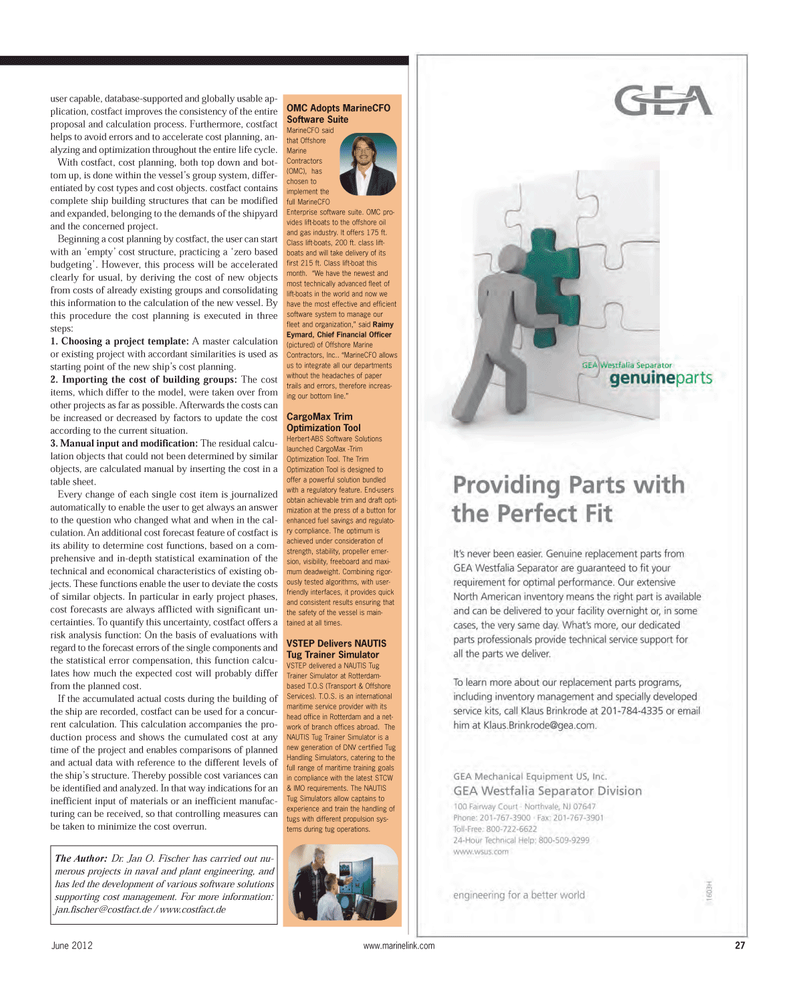
Page 27: of Maritime Reporter Magazine (June 2012)
Annual World Yearbook
Read this page in Pdf, Flash or Html5 edition of June 2012 Maritime Reporter Magazine
June 2012www.marinelink.com 27OMC Adopts MarineCFOSoftware Suite MarineCFO saidthat Offshore MarineContractors(OMC), haschosen toimplement thefull MarineCFOEnterprise software suite. OMC pro- vides lift-boats to the offshore oil and gas industry. It offers 175 ft. Class lift-boats, 200 ft. class lift-boats and will take delivery of itsfirst 215 ft. Class lift-boat thismonth. ?We have the newest and most technically advanced fleet oflift-boats in the world and now wehave the most effective and efficient software system to manage our fleet and organization,? said RaimyEymard, Chief Financial Officer (pictured) of Offshore Marine Contractors, Inc.. ?MarineCFO allowsus to integrate all our departments without the headaches of papertrails and errors, therefore increas- ing our bottom line.?CargoMax Trim Optimization Tool Herbert-ABS Software Solutions launched CargoMax -Trim Optimization Tool. The Trim Optimization Tool is designed to offer a powerful solution bundled with a regulatory feature. End-users obtain achievable trim and draft opti-mization at the press of a button for enhanced fuel savings and regulato- ry compliance. The optimum isachieved under consideration ofstrength, stability, propeller emer- sion, visibility, freeboard and maxi- mum deadweight. Combining rigor-ously tested algorithms, with user-friendly interfaces, it provides quick and consistent results ensuring that the safety of the vessel is main-tained at all times.VSTEP Delivers NAUTISTug Trainer Simulator VSTEP delivered a NAUTIS Tug Trainer Simulator at Rotterdam- based T.O.S (Transport & Offshore Services). T.O.S. is an international maritime service provider with its head office in Rotterdam and a net- work of branch offices abroad. The NAUTIS Tug Trainer Simulator is a new generation of DNV certified Tug Handling Simulators, catering to thefull range of maritime training goalsin compliance with the latest STCW& IMO requirements. The NAUTIS Tug Simulators allow captains to experience and train the handling oftugs with different propulsion sys- tems during tug operations. user capable, database-supported and globally usable ap-plication, costfact improves the consistency of the entire proposal and calculation process. Furthermore, costfact helps to avoid errors and to accelerate cost planning, an- alyzing and optimization throughout the entire life cycle. With costfact, cost planning, both top down and bot- tom up, is done within the vessel?s group system, differ- entiated by cost types and cost objects. costfact contains complete ship building structures that can be modified and expanded, belonging to the demands of the shipyard and the concerned project.Beginning a cost planning by costfact, the user can start with an ?empty? cost structure, practicing a ?zero based budgeting?. However, this process will be accelerated clearly for usual, by deriving the cost of new objects from costs of already existing groups and consolidating this information to the calculation of the new vessel. By this procedure the cost planning is executed in three steps:1. Choosing a project template: A master calculationor existing project with accordant similarities is used as starting point of the new ship?s cost planning. 2. Importing the cost of building groups: The costitems, which differ to the model, were taken over from other projects as far as possible. Afterwards the costs can be increased or decreased by factors to update the cost according to the current situation.3. Manual input and modification: The residual calcu-lation objects that could not been determined by similarobjects, are calculated manual by inserting the cost in atable sheet.Every change of each single cost item is journalized automatically to enable the user to get always an answer to the question who changed what and when in the cal-culation. An additional cost forecast feature of costfact is its ability to determine cost functions, based on a com-prehensive and in-depth statistical examination of the technical and economical characteristics of existing ob- jects. These functions enable the user to deviate the costs of similar objects. In particular in early project phases,cost forecasts are always afflicted with significant un- certainties. To quantify this uncertainty, costfact offers a risk analysis function: On the basis of evaluations with regard to the forecast errors of the single components and the statistical error compensation, this function calcu-lates how much the expected cost will probably differ from the planned cost.If the accumulated actual costs during the building of the ship are recorded, costfact can be used for a concur- rent calculation. This calculation accompanies the pro- duction process and shows the cumulated cost at any time of the project and enables comparisons of plannedand actual data with reference to the different levels of the ship?s structure. Thereby possible cost variances can be identified and analyzed. In that way indications for an inefficient input of materials or an inefficient manufac- turing can be received, so that controlling measures can be taken to minimize the cost overrun. The Author: Dr. Jan O. Fischer has carried out nu- merous projects in naval and plant engineering, and has led the development of various software solutions supporting cost management. For more information: [email protected] / www.costfact.de MR June12 # 4 (25-33):MR Template 6/11/2012 4:12 PM Page 27

 26
26

 28
28
